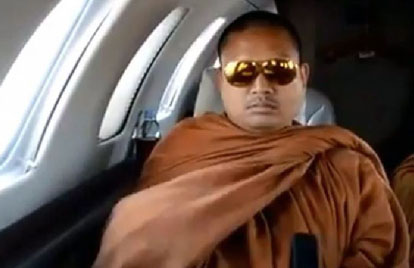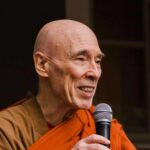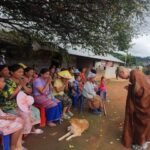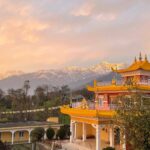A number of prominent scandals have recently surfaced from the Sangha community, leading to public outcry and confusion. One involves a famous foreign monk who abruptly disrobed after 37 years in the monkhood. He has a lot of followers as many Thais, especially in the middle and upper classes, greatly respect him. Another involves a monk who owns a fleet of luxurious cars and a private jet, calls himself an “arahant” (the Holy One), goes shopping in Paris, is found kissing a young novice in a photograph, and plans to donate a number of expensive vehicles to high-ranking monks in the ecclesiastical order. Still another concerns two monks openly challenging one another for a public debate. Small wonder that many have declared that it is dark times for Buddhism in Siam or that the religion is nearing its end. There is a kernel of truth in this observation, but the problem is also much more complicated and deserves to be carefully unpacked.


We must begin by understanding that the Buddha founded and practiced the Dhamma and then achieved Enlightenment. In other words, he underwent transformation (i.e., experienced rupture, liberation from defilements and self-attachments) from an ordinary person to become the Enlightened One. The Buddha and the Dhamma are inextricable from one another. This is especially true when the Buddha first delivered his teachings to five disciples, who ultimately asked to be ordained, establishing the first Sangha community. As such, the Three Jewels of the Buddha, the Dhamma and the Sangha were born.
Bhikkhus and bhikkhunis are individuals who are in search of a noble life—a sublime, celibate and chaste life. They have rejected lay life, which entails compromises with violence and exploitation on a daily level, to live in a noble community based on equality, solidarity and freedom from greed, hatred and delusion. Ambedkar was thus correct to point out that the Sangha was the first democratic community in the world.
The Buddha passed away after spreading his teachings for 45 years. He did not name a successor to take his stead. He simply stated that the Dhamma-Vinaya (the Doctrine and the Discipline) would be the teacher when he was gone. In other words, as long as Buddhists continue to uphold and practice the Dhamma-Vinaya, the religion will survive. If not, it will simply fade away according to the law of the Three Characteristics of Existence. Put another way, Buddhism will not survive if Buddhists assume that someone else (e.g., monks) will maintain it for them.
Thus Thais who are concerned about the fate of Buddhism in the country must ask themselves an important question: are we genuine practitioners of the Dhamma-Vinaya and do we seek refuge in the Buddha, the Dhamma and the Sangha in order to liberate ourselves from suffering or are we Buddhist only in name—someone who sees the Buddha as an image that will make us richer, healthier, more powerful, more popular, and so on. Put bluntly, do we reduce the Buddha to being a magic phallus amulet (paladkik)?
The Dhamma is the Doctrine and the Vinaya, the Discipline. When we have faith in the Buddha’s teachings, we practice the discipline. At the heart of the Buddha’s teachings is the reduction and eventual overcoming of selfishness in order to help others, including other living beings and the natural environment. This entails the transformation of greed into generosity, hatred into love or loving-kindness, and delusion into wisdom. All these features are contrary to the dominant values of capitalism and consumerism. The point is that if we don’t understand the new religion of capitalism and consumerism, the teachings of the Buddha will never find a way into our hearts. For instance, an act of charity or merit-making can actually be a form of expressing and strengthening self-attachment. The meditation retreats that we take can actually work to pacify and make us escape back into ‘reality’, which is underpinned by various modes of violence and injustices, from which we in the middle and upper classes benefit on a daily level. Acts such as merit-making and meditation will never enable us to understand the Buddha’s teachings.
The act of giving (dana) is a means to lessen selfishness. If in giving one (secretly) hopes to reap benefits in return such as good fortune, a place in heaven, etc., it is simply a way of increasing selfishness. Buddhism envisions different modes of giving. At the most basic level is the donation of materials (amisadana) such as food, clothes, lodging, medicines, and so on. We can begin by giving things we have in excess and then proceed to things that we hold dear—including our family life. More important than material gifts is Dhammadana or the gift of Truth or Dhamma. This is not about donating things such as Dhamma books and CDs because these are material gifts and can be seen as amisadana. Rather it entails speaking the truth to power, truth-telling in a deceitful and hypocritical society. As such, the gift of Dhamma requires moral courage as well as the willingness to assume all the risks and consequences of speaking the truth. Finally there is abhayadana or forgiveness, which is derived from the absence of fear. Our most immediate and intimate enemies are the greed, hatred and delusion in us. We fear being poor; losing power, security, exclusive status or fame; not having knowledge; succumbing to sickness and death; and so on. If we gradually overcome these fears we will not see others as enemies—including other religions, nations, ethnic groups, etc. More specifically, we may still be in conflict with them but we will not hate and dehumanize them. With forgiveness “we” becomes non-exclusionary, and this paves the way
toward solidarity.
Morality or sila is a means to cultivate ‘normality,’ meaning a life based on non-domination and non-exploitation of self and others. The Five Precepts are intended for this matter. As Alan Watts, who was one of the first British Buddhists, explained why he became a vegetarian: “Cows cry louder than cabbage.”
If one finds the Buddha’s teachings appealing and feels ready to be ordained in order to pursue a noble life, then one inevitably has to accept the Discipline or set of practices and prohibitions that when violated would also terminate one’s status as monk. These are the acts of sexual intercourse, killing, stealing and faking extraordinary achievement. Put another way, a life of non-domination and non-exploitation requires upholding celibacy and chastity, eating and sleeping little, leading a simple and humble life, and not having a job. Life is nourished solely by asking or begging for food. All food is almsfood. Clothes come from patching together old cloths left behind by the dead or thrown away. Medicines come from mixing herbs found in the jungle with urine. And so on. This is a way of life that challenges or ruptures the mores of society.
Having no job also means that monks cannot possess money. Upholding the Tenth Precept (i.e., abstaining from accepting money) is what truly distinguishes the ordained from the lay Buddhist. A lay person can abstain from sex, minimize food consumption, and lead a simple life. But s/he must work and earn money in order to survive—hoping at least that the job is based on Right Livelihood.
Unfortunately, it seems that many leading monks in Thai society all have a career. They go to deliver sermons and receive financial contributions (now called a necessity in life) in return. The size of a financial contribution also depends on the monk’s popularity and ecclesiastical rank. Some also sell amulets, holy water, etc. on the side. A number of them have used the money obtained for a good cause like building schools and hospitals. But since when is it a duty of monks to gather money to build schools? Therefore, the recent case of Luang Pu (Elder Monk) Nen Kam Chattigo is extreme but definitely not anomalous.
If an ordained cannot maintain celibacy and chastity, then disrobing is always a good option. S/he may turn into a good lay person. This is better than remaining a shameless, fake monk. Fake monks are widespread in the Thai Sangha community. Many have ecclesiastical titles and high administrative positions. Many no longer have time to meditate and engage in critical self-reflection in order to further improve themselves. Many don’t have virtuous companions to provide them with sincere criticisms. Rather they surround themselves with sycophants. Many seek to increase their power and wealth by pandering to the forces of absolutism, capitalism and nationalism. And so on. In sum, Nen Kam is but the tip of an iceberg.
Sulak Sivaraksa











